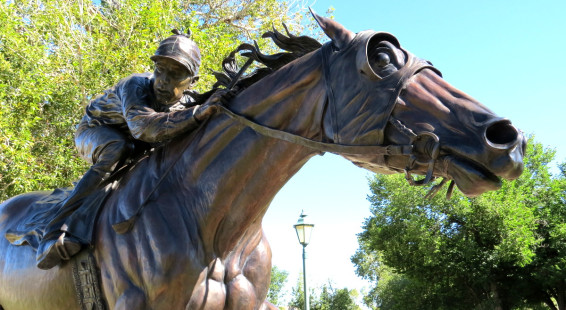
Sitting on the grounds of the Reynold’s Carriage Museum in Cardston, Alberta is a statue of jockey and his mount, seeming to move at top speed while standing still.
The statue captures a moment in time when local boy turned legendary jockey, George Woolf, rode Seabiscuit to one of the greatest victories in horse racing history. On November 1, 1938, in what was dubbed the “Race of the Century”, Seabiscuit was pitted against Triple Crown winner War Admiral. During the race Seabiscuit broke War Admiral and as he surged to victory, Wolff turned to War Admiral’s jockey (Charley Kurtsinger) and said, “So Long Charley”. It’s one of those phrases that has become part of our everyday vernacular.
Another great moment for the pair occurred on March 2, 1940, when Seabiscuit won the Santa Anita Handicap, becoming the richest horse in the world while capturing the $100,00 purse and cementing a place as one of the top racing horses ever. Woolf was just 29 years old at the time.

George Woolf was born into a family that loved horses. His father was a stagecoach driver and rancher who “never had much money but always owned a fast horse.” Woolf’s mother was a circus acrobat who performed on the back of a horse. As a teenager, Woolf began riding at racetracks and grew in skill and reputation. He was always cool and never panicked, even in the most chaotic race, and earned the nickname of “Iceman”.
Woolf was a severe diabetic at a time when that disease was not well understood or well treated. It is likely that diabetes caused him to lose consciousness during a race in 1946; he fell to the track and was killed at the age of 35.
(Click on thumbnails to enlarge photos)